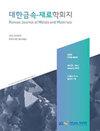利用转化焦炉煤气两阶段直接还原铁工艺的实验室工艺参数测定
IF 1.4
4区 材料科学
Q4 MATERIALS SCIENCE, MULTIDISCIPLINARY
引用次数: 0
摘要
在实现碳中和的道路上,人们对DRI(直接还原铁)工艺等新兴技术给予了极大的关注。提出了一种利用焦炉煤气改造的两阶段DRI工艺,并确定了最佳工艺参数。通过对样品失重情况的监测,以及不同还原环境下反应温度和操作时间的EDS和XRD测量,考察了Carajás铁矿石在现场的还原和碳化效果。无论还原环境如何,铁矿石在800℃下的还原均可在60 min内完成,而还原后的铁只有在800℃且还原气体中氢含量高的情况下才能实现碳化。因此,在提议的DRI工艺中采用逆流方案是合理的,其中含有高氢含量的COG流入800℃的第二阶段,随后流入600℃的第一阶段。无论还原环境如何,铁矿石在第一阶段开始还原60 min,在高还原环境下,在第二阶段完成还原和后续碳化40 min。平衡分析表明,COG中CH4裂解生成石墨,导致CO2生成CO, Fe还原生成Fe3C。铁矿石的碳化只有在有二氧化碳存在的情况下才有可能。研究还表明,过高或过低的还原环境都不利于DRI过程的完成。本研究有望为类似DRI工艺的优化提供有效的指导。本文章由计算机程序翻译,如有差异,请以英文原文为准。
Lab-scale Process Parameter Determination of a Two-stage DRI (direct reduced iron) Process Using Reformed COG (coke oven gas)
On the road to carbon neutrality, a great deal of attention is being paid to emerging technologies such as the DRI (direct reduced iron) process. This study proposes a two-stage DRI process using reformed COG (coke oven gas), and determined optimal process parameters. The reduction and carbonization of Carajás iron ore used in the field were examined by monitoring the weight loss of the samples, and EDS and XRD measurements with respect to the reaction temperature and operating time for different reducing environments. While the reduction of iron ore is completed in 60 min at 800oC regardless of the reducing environment, the carbonization of reduced iron is attainable only at 800oC with high hydrogen content in the reducing gas. Thus, a countercurrent scheme in the proposed DRI process is justified, in which COG containing high hydrogen content is flowed into the 2nd stage operated at 800oC and subsequently directed to the 1st stage operated at 600oC. The reduction of iron ore is initiated in the 1st stage for 60 min irrespective of the reducing environment, and the completion of the reduction and the following carbonization is fulfilled in the 2nd stage for 40 min under a high reducing environment. An equilibrium analysis supported that the cracking of CH4 in COG to graphite leads to the formation of CO from CO2 and the successive formation of Fe3C from reduced Fe. The carbonization of iron ore is possible only in the presence of CO2 . It also showed that too high or low reducing environments are not desirable to accomplish the DRI process. This study is expected to be provide an effective guideline for optimizing similar DRI processes.
求助全文
通过发布文献求助,成功后即可免费获取论文全文。
去求助
来源期刊

Korean Journal of Metals and Materials
MATERIALS SCIENCE, MULTIDISCIPLINARY-METALLURGY & METALLURGICAL ENGINEERING
CiteScore
1.80
自引率
58.30%
发文量
100
审稿时长
4-8 weeks
期刊介绍:
The Korean Journal of Metals and Materials is a representative Korean-language journal of the Korean Institute of Metals and Materials (KIM); it publishes domestic and foreign academic papers related to metals and materials, in abroad range of fields from metals and materials to nano-materials, biomaterials, functional materials, energy materials, and new materials, and its official ISO designation is Korean J. Met. Mater.
 求助内容:
求助内容: 应助结果提醒方式:
应助结果提醒方式:


